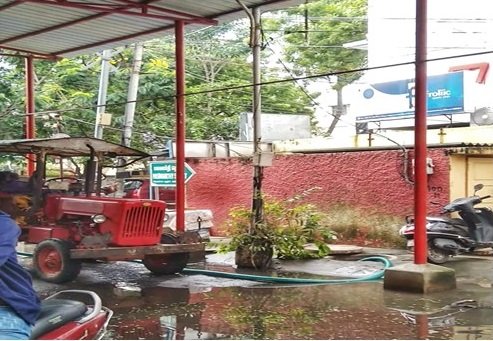Read in : தமிழ்
Over many days since November 12, the unusual sight of farm tractors chugging along small roads in several core areas of Chennai has greeted residents. These hardy machines with a water pump strapped on at the rear were snaking fat hoses into storm water drains in residential localities and pumping water out — evidence of a malfunctioning storm water drain system. The water pumped out was being dumped into larger streets which have bigger sewer connections capable of pumping millions of litres out.
Many roads in the core city acquired the appearance of a disaster zone, their surfaces eroded severely, trenches dug randomly to relieve stagnation, and crude obstacles placed to prevent vehicular movement in a bustling city.
By Monday, November 15, many of these interior streets had been cleared, helped by two preceding days of sunshine. Many roads were still partially blocked by the remains of fallen trees, mainly leaves and small branches, awaiting clearing crews of the Greater Chennai Corporation. The lucrative large trunk and bigger branches of the trees had been logged and removed quickly. Mambalam’s ‘flood carrier’, Madley Road vehicular subway just beyond the busy T. Nagar bus stand, was among the last to be cleared.
Yet, a wave of worry was sweeping Chennai as the India Meteorological Department (IMD) issued a fresh alert: expect heavy to very heavy rainfall along north coastal Tamil Nadu, along with southern Andhra Pradesh, between November 17 and 19. BBC’s weather forecast matched this, with the heaviest probability of 91% rainfall reserved for the afternoon of November 18.
In IMD literature, heavy and very heavy rainfall equates 64.5 – 115.5 mm and 115.6 – 204.4 mm respectively, presenting the frightening possibility that some parts of the city could expect rainfall of the kind that deluged it between November 7 and 11, if not the black swan catastrophe of 2015.
Creating fresh capacity
The beleaguered DMK government of M.K. Stalin – who has been seen in a hardy Range Rover touring rain-hit areas in Chennai and other districts, often distributing assistance – must now prepare for a possible Round Two in NE Monsoon 2021.
The government has a limited kit of options. After round one, it deployed pumps to drain out water from the SWD network in problem spots, apparently hoping to create fresh flood-absorbing capacity. Since the network is not full-fledged and has lost its integrity due to poor maintenance, it can only play a limited storage role. Having bootstrapped the SWD system onto the larger sewer network, with active pumping of water from streets, this method offers the government a choice during a fresh flood.
Since the storm water drain network is not full-fledged and has lost its integrity due to poor maintenance, it can only play a limited storage role.
A second crisis is the paralysis from power cuts. In a heavily digitalised economy of services, absence of power and disrupted connectivity inflicts costs on everyone, including the government. It may be unavoidable to switch off power in many localities with weak housing and mounting water levels for safety, but Tamil Nadu’s electricity utility TANGEDCO has to be nimble, and ensure that its staff are responsive, to restore power as quickly as possible. There is also a tendency to use the flood bottleneck to collect bribes.
There are now recorded instances, in West Mambalam’s station road area, for instance, of electricity utility staff asking residents in adjacent streets to pool money and pay for flood-destroyed equipment including costly cables, for speedy restoration. Of course, residents may not get receipts. Interestingly, TANGEDCO launched a Rs 2,549 crore project during the erstwhile AIADMK regime, with a completion goal of 2020-21, to convert about 2,004 km of high tension and 33,307 km of low tension electrical cables into an underground cable system, to remove the risks during flooding and cyclones. It is now left to the new special panel under retired IAS officer V. Thiruppugazh to see how much of this has been completed, and how effectively it works.
TANGEDCO has to be nimble, and ensure that its staff are responsive, to restore power as quickly as possible. There is also a tendency to use the flood bottleneck to collect bribes.
There is also the issue of damaged electrical and electronic equipment in homes. Many residents have lost chargers, adapters, routers, and more expensive gadgets to the erratic quality and supply of power during the monsoon. The city administration can compensate them at least partially, either directly as a discount on their civic bills and profession tax, or as a universal ex-gratia payment to all residents. In 2019, the AIADMK government announced Rs. 2,000 each to 60 lakh families below the poverty line, as relief for Cyclone Gaja. There are other instances of cash payments as relief including for COVID-19.
Such “cash compensation” payments to ration card holders appears inevitable for a government under pressure to conduct urban local body elections, the latest and difficult deadline being December. The culture of relief payments is fully entrenched, with people expecting such a move from successive governments. Removing the underlying causes, which are insufficient and unscientific storm drain construction, absence of links to surviving urban tanks including temple tanks, loss of suburban lakes and silted drinking water reservoirs, will take a major effort.
There is the lost opportunity of lake desilting in Chennai, Kancheepuram, Chengalpattu and Thiruvallur. The erstwhile Edappadi Palaniswamy regime’s “free silt for farmers from desilted tanks” plan left out these districts, according to the State Disaster Management Perspective Plan, 2018-2030.
Read in : தமிழ்











